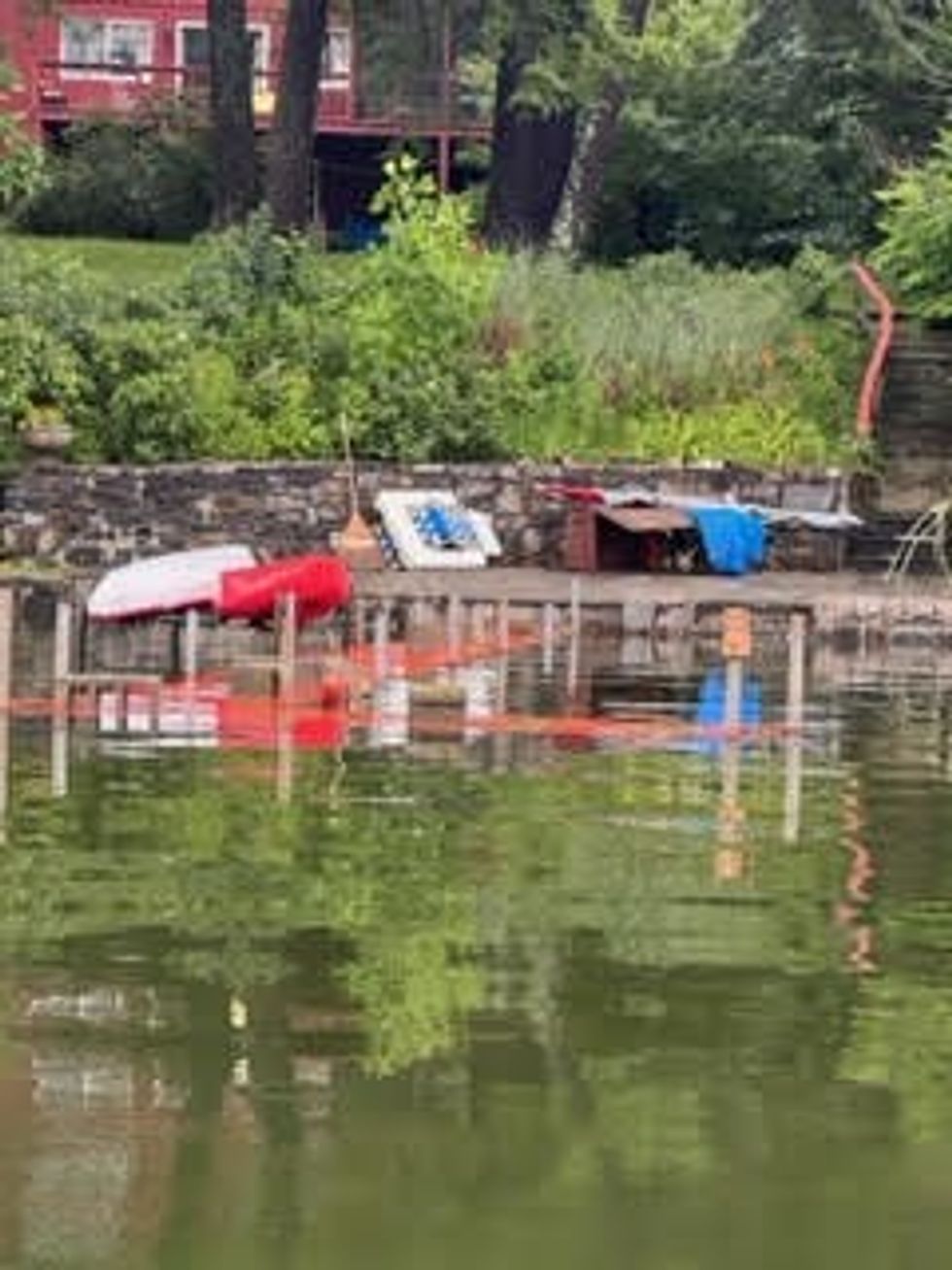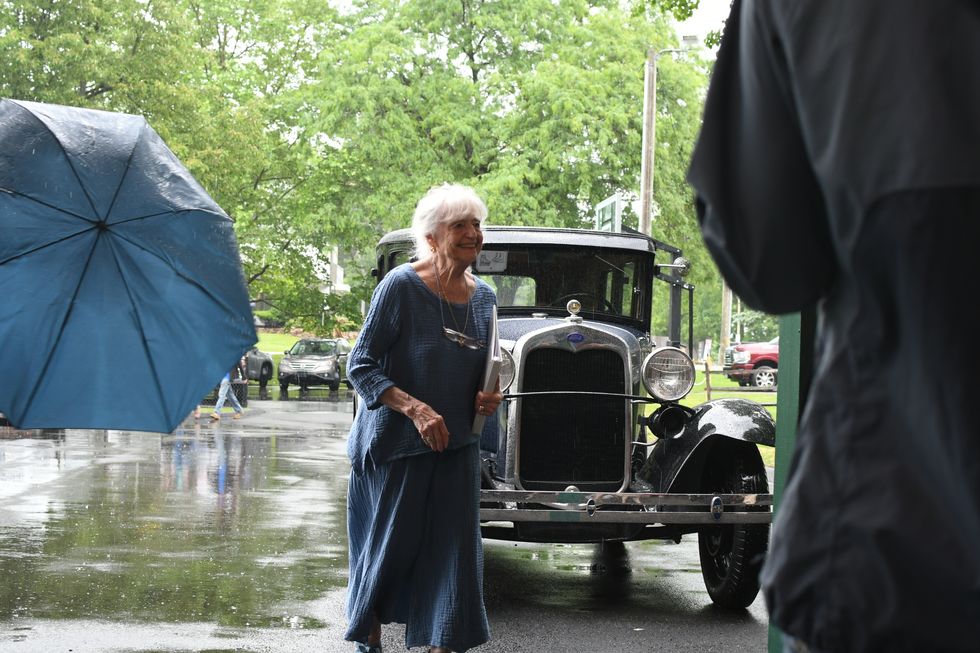
Twin Lakes residents dealt with flooded docks after heavy rains last week.
Photo by Dan Kadlec

SALISBURY — Sustained heavy rainfall this month has raised the water level at the Twin Lakes by at least a foot, swamping docks and causing headaches for boat and property owners.
“The impact on homeowners has mainly been having to move boats to moorings and having to put weights on docks to keep them from floating away,” said Grant Bogle, president of the Twin Lakes Association, on Saturday, July 22.
The TLA official estimated that the majority of stationary docks on Twin Lakes were either under water at some point or the water was cresting above the docks at the peak due to waves and wind.
Although water levels have eased in recent days, lake officials said it may persist for several more weeks, especially in the East Twin, which must push water through a narrow passage to drain and thus responds more slowly to the open gate at the end of the channel feeding Shenob Brook.
According to the organization’s July newsletter, with rain this month coming at “seven times the normal amount,” lake levels have been difficult to manage even though the channel gates have been wide open for weeks.
Boat owners are advised to lengthen ropes used to tie up at their dock or risk damage to their boat or dock as the rope tightens.
But even on days without rain, the lake has risen as runoff from surrounding hills flows into the lake system, said officials, noting that long-time residents say they haven’t seen such a sustained high lake level in many decades.
But there may be a silver lining. The heavy rainfall not only helped clear smog pushing south from the Canadian wildfires, but it also helped disperse unsightly but non-toxic algae blooms, known as Green Filamentous, due to nutrient load in the lake.
This algae bloom, said lake officials, is not to be confused with the more concerning cyanobacteria, which may have a harmful effect on children and pets.
The TLA is awaiting approval from the state Department of Energy and Environmental Protection (DEEP) to treat invasive weeds.
TLA officials said the increasingly stringent testing process required by the state is largely responsible for the late treatment this year, which normally takes place near the end of June but is expected to happen by the end of July.
“We submitted our permit application at the end of February, and we are hopeful that we will receive approval shortly,” said Bogle. “Going forward, we will endeavor to submit our application even earlier to give the DEEP as much time as possible to issue the permit, which should allow us to treat earlier in the season.”
Earlier treatment is more effective, lake officials noted, but even a late treatment is better than skipping a year.
Bogle explained that the algae bloom seen this year around the Twin Lakes, as well as nearby Lake Wononscopomuc and other lakes in the Northeast, is not directly related to the late treatment of the milfoil, but by runoff and nutrient flow into the lake.
“This is why we are increasing our efforts to educate the community about the steps each homeowner can take to reduce runoff and nutrient flow into the lake.”
While not harmful, the algae bloom is unsightly and suggests rising levels of nitrogen, and TLA officials are urging property owners around the lake and throughout the watershed to minimize use of fertilizer containing phosphorous, which spurs algae blooms. They also recommend planting buffers between lawns and the shoreline.
Bunny McGuire, at center holding the big scissors, surrounded by her family as she cuts the ribbon to the park that now bears her name in North Canaan on Saturday, June 7.
NORTH CANAAN — The park on Main Street in North Canaan was officially renamed Bunny McGuire Park at a ceremony beneath the pavilion Saturday, June 7.
Clementine “Bunny” McGuire was recognized for her lifelong commitment to volunteerism in town. Her civil contributions include work with the Beautification Committee, the Douglas Library, the historical society, a poll worker, an employee of North Canaan Elementary and Housatonic Valley Regional High Schools and a volunteer at her church.
“People like Bunny are the lifeblood of small towns and we should all be grateful for the bountiful benefits we have derived from having this vital and generous force in our midst,” said Kathryn Boughton, town historian.
First Selectman Brian Ohler described McGuire as, “A person whose name is truly synonymous with service, kindness, civility and generosity.”

Ohler noted the impact McGuire has had on the town, as evidenced by the nearly 100 guests in attendance and the long list of donors who contributed to updating the facilities at the park.
“Bunny, you are so, so loved. The outpouring of support is not a surprise,” said Ohler.
Among the recent improvements include a new dog park fenced area, basketball hoops, updated playground, parking lot pavement, landscaping, new signage, paint and lighting for the pavilion.
“Everyone says I have done so much for the town, but this town has done so much for me,” said McGuire. “Just look around you, what we have,” she said tearfully. “A big thank you to all of you. I love you.”
SHARON — Angela Derrick Carabine, 74, died May 16, 2025, at Vassar Hospital in Poughkeepsie, New York. She was the wife of Michael Carabine and mother of Caitlin Carabine McLean.
A funeral Mass will be celebrated on June 6 at 11:00 a.m. at Saint Katri (St Bernards Church) Church. Burial will follow at St. Bernards Cemetery. A complete obituary can be found on the website of the Kenny Funeral home kennyfuneralhomes.com.
Sam Waterston
On June 7 at 3 p.m., the Triplex Cinema in Great Barrington will host a benefit screening of “The Killing Fields,” Roland Joffé’s 1984 drama about the Khmer Rouge and the two journalists, Cambodian Dith Pran and New York Times correspondent Sydney Schanberg, whose story carried the weight of a nation’s tragedy.
The film, which earned three Academy Awards and seven nominations — including one for Best Actor for Sam Waterston — will be followed by a rare conversation between Waterston and his longtime collaborator and acclaimed television and theater director Matthew Penn.
“This came out of the blue,” Waterston said of the Triplex invitation, “but I love the town, I love this area. We raised our kids here in the Northwest Corner and it’s been good for them and good for us.”
Waterston hasn’t seen the film in decades but its impact has always remained present.
“It was a major event in my life at the time,” Waterston said of filming “The Killing Fields,” “and it had a big influence on me and my life ever after.” He remembers the shoot vividly. “My adrenaline was running high and the part of Sydney Schanberg was so complicated, so interesting.”
Waterston lobbied for the role of the Pulitzer Prize-winning journalist for years, tracing his early interest to a serendipitous connection while filming in England. Even before Joffé’s production was greenlit, he had his sights set on playing the role. “I knew I wanted the part for years even before it was a movie that was being produced.”
What followed was not just critical acclaim, but also a political awakening. “The film gave all of us an intimate acquaintance with refugees, what it is to be a refugee, how the world forgets them and what a terrible crime that is.”
In Boston, at a press stop for the film, two women asked Waterston a pointed question: now that he knew what he knew, what was he going to do about it? “I said, ‘Well, you know, I’m an actor, so I thought I’d go on acting.’ And they said, ‘No, that’s not what you need to do. You need to join Refugees International.’” And join he did, serving on the organization’s board for 25 years.
Both Schanberg and Dith Pran, whose life the film also chronicles, were “cooperative and helpful … in a million ways,” Waterston said. Upon first meeting Pran, Waterston recalled, “He came up to me, made a fist, and pounded on my chest really hard and said, ‘You must understand that Sydney is very strong here.’ He was trying to plant something in me.”
There were more tender gestures, too. Schanberg used the New York Times wire to relay that Waterston’s wife had just given birth while he was filming in Thailand, adding to the personal and emotional connection to the production.
Though “The Killing Fields” is a historical document, its truths still resonate deeply today. “Corruption is a real thing,” Waterston warned. “Journalism is an absolutely essential part of our democracy that is as under siege today as it was then. It’s different now but it’s the same thing of ‘Don’t tell the stories we don’t want heard.’ Without journalists, we are dust in the wind.” Waterston added, “Democracy is built on the consent of the governed but the other thing it’s built on is participation of the governed and without full participation, democracy really doesn’t stand much of a chance. It’s kind of a dead man walking.”
When asked what he hopes the audience will take away from the screening, Waterston didn’t hesitate. “This is the story that puts the victims of war at the center of the story and breaks your heart. I think that does people a world of good to have their hearts broken about something that’s true. So, I hope that’s what the impact will be now.”
Tickets for the benefit screening are available at www.thetriplex.org. Proceeds support Triplex Cinema, a nonprofit home for film and community programming in the Berkshires.